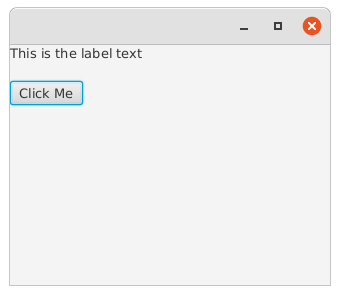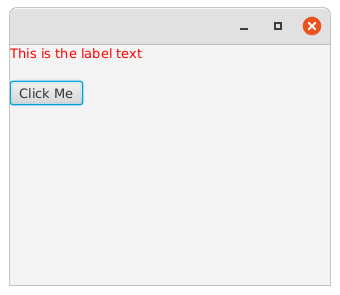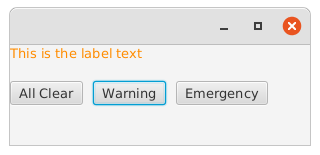What’s a PseudoClass?
Have you ever noticed how a Button changes a little when you hover your mouse over it? Or darkens to look like it’s pressed down when you hold down a mouse button in it? These presentation changes are usually accomplished through the use of PseudoClasses.
PseudoClasses are specialized CSS selectors which represent on/off states of some value of a Node. One or more aspects of the styling of a Node will be changed when the PseudoClass is turned on, and then returned back to their original state when the PseudoClass is turned off again.
They’re useful because the styling is all handled for you behind the scenes. The normal use case is to tie the PseudoClass state to a Boolean Property, and then bind that Property to a Property in the Model or some other part of the GUI. Sometimes the PseudoClass state is control by EventHandlers.
Built-In PseudoClasses
There are a number of predefined PseudoClasses in JavaFX that you can use without any special programming. For instance, many controls have a disabled pseudo class which is automatically maintained for you whenever the control’s Disabled property changes.
The standard Modena CSS has definitions like this:
.spinner:disabled {
-fx-opacity: 0.4;
}
You can override these in your own stylesheets to make the control behave differently when it’s disabled.
Create Your Own PseudoClass
The built-in PseudoClasses are useful, but sometimes you need to create your own PseudoClass to handle state changes in ways unique to your application. For instance, you might want to change the colour of a Label if the data it displays indicates an error condition.
This article is about how to create a brand new PseudoClass and how to link it into your screen Node so that you can style it via your CSS.
The JavaDocs for Pseudoclass are Horrible
If you want to look, you can find them here.
The introduction at the top reads like this:
PseudoClass represents one unique pseudo-class state. Introducing a pseudo-class into a JavaFX class only requires that the method Node.pseudoClassStateChanged(javafx.css.PseudoClass, boolean) be called when the pseudo-class state changes. Typically, the pseudoClassStateChanged method is called from the protected void invalidated() method of one of the property base classes in the javafx.beans.property package.
Note that if a node has a default pseudo-class state, a horizontal orientation for example, pseudoClassStateChanged should be called from the constructor to set the initial state.
The following example would allow “xyzzy” to be used as a pseudo-class in a CSS selector.
Yikes! That doesn’t really explain anything unless you already understand it.
And then they’ve included the following example code:
public boolean isMagic() {
return magic.get();
}
public BooleanProperty magicProperty() {
return magic;
}
public BooleanProperty magic =
new BooleanPropertyBase(false) {
@Override protected void invalidated() {
pseudoClassStateChanged(MAGIC_PSEUDO_CLASS, get());
}
@Override public Object getBean() {
return MyControl.this;
}
@Override public String getName() {
return "magic";
}
}
private static final PseudoClass
MAGIC_PSEUDO_CLASS = PseudoClass.getPseudoClass("xyzzy");
Seriously, I don’t think this is a great way to explain how it works. They’ve even called it magicProperty, which might be an admission that they understood they weren’t explaining it very well when they wrote it.
MyControl.this isn’t defined anywhere, but it appears that this snippet of code is supposed to be embedded into a class which is an extension of Node. The idea being that this class now exposes a BooleanProperty through magicProperty() that the layout can then bind to some other property to control the PseudoClass.
Also, there’s a typo (which I’ve fixed here) in the call to pseudoClassStateChanged(). That doesn’t help either.
How Does it Really Work?
In reality, PseudoClass is a lot easier to understand than you might think. There’s no magic, and it’s really easy to use PseudoClass.
Creating the PseudoClass
In the example code from the JavaDocs, the first part that’s really important is the single line:
private static final PseudoClass
MAGIC_PSEUDO_CLASS = PseudoClass.getPseudoClass("xyzzy");
What does this do?
It does two things, one you can see, and one that you can’t.
The first is to create an instance of PseudoClass as a static field. Does it need to be static? Technically, no, but as we’ll see in a little bit, it’s probably a good idea to implement it this way.
The second thing it does, which you cannot see, is that it updates a static Map deep inside PseudoClass, adding whatever name you used to initialize your PseudoClass - in this case, “xyzzy”. The Map makes sure that only one element with the same name exists in your application.
If you try to instantiate another PseudoClass anywhere in your application with the same name, it will just reuse the Map entry it already has for that name. That’s not really a big deal, but you should avoid using names that are already defined in JavaFX, like “hover” or “disabled”, because there might already be code that’s going to be manipulating any PseudoClasses with that name.
Setting the PseudoClass Value
The only other part of the example code you need to understand is this:
@Override protected void invalidated() {
pseudoClassStateChanged(MAGIC_PSEUDO_CLASS, get());
}
Even this is too complicated. You could use something like this:
pseudoClassStateChanged(MAGIC_PSEUDO_CLASS, true);
What does this do? pseudoClassStateChanged() is a method in Node. You pass it a PseudoClass, and a new value (true or false) for that PseudoClass in that Node. Under the hood, this method then adds or removes this PseudoClass to its list of active PseudoClasses. In reality, this list is really just a list of the names that were given to the PseudoClasses when they were instantiated.
Important Things to Know About PseudoClass
- PseudoClass isn’t part of the Node
- The
PseudoClassitself isn’t installed into theNode, formally declared as part of it, or prepped in theNodein any special way at all. You can instantiate aPseudoClassanywhere and pass it to anyNode’spseudoClassStateChanged()method, and it will work. Furthermore, you can call aNode'spseudoClassStateChanged()from any number of places using completely different instances of aPseudoClasswith the same name, and it will work exactly the same as if you had only used one instance of the samePseudoClassrepeatedly. - Node.pseudoClassStateChanged() is a public method.
- This means that there’s no need to extend any
Nodejust to implement aPseudoClasson it. You can manage thePseudoClasseson aNodefrom outside theNode. This is absolutely not clear from the JavaDoc example. - The mechanism connecting PseudoClass to CSS isn’t our concern
- How the
Nodeactually turns the list of activePseudoClassesinto styling changes an your screen is something that we simply don’t need to know. As long as your CSS has the selectors defined, it will work. - PseudoClass itself isn’t Reactive
- It’s important to note that
pseudoClassStateChanged()itself has NOTHING to do with Properties or Bindings. It’s a plain vanilla Java method. - PseudoClass instances aren’t functionally unique
- There is nothing particularly special or specific about any instance of
PseudoClassother than its name and the way that names are managed. The following code is perfectly fine:PseudoClass xyzzy = PseudoClass.getPseudoClass("xyzzy"); myButton.pseudoClassStateChanged(xyzzy, true);It’s probably a bit inefficient if it’s going to be called a lot, just because there’s a fair bit of code running inside of
PseudoClass.getPseudoClass(). So it might be best to declare it as a static field inside of whatever class holds this code.
Connecting PseudoClasses to Properties and Bindings
We’ve seen that PseudoClasses are just normal Java and are implemented through normal imperative programming techniques. But if you want to build a reactive JavaFX application, then you need to control the PseudoClasses through Properties and Bindings.
How do you do that?
The way to connect imperative code to Properties is through Invalidation Listeners. This is exactly what the example from the JavaDocs does, although it does it in the most complicated way possible.
Essentially, what an Invalidation Listener does is to define a block of code that will run whenever the system decides that the value held in a property is no longer valid because it’s potentially been changed, or some other properties that it’s been bound to have changed. Calling get() on the Property will cause it to recalculate it’s value, but you can also run whatever other code you want in the Listener. This is where you can call Node.pseudoClassStateChanged().
The Property that you’re listening to can be anything, anywhere. It doesn’t need to be a field in the Node, and it doesn’t need to be a BooleanProperty either. The Listener just needs to be defined in some scope that has access to both the Node and the Property. The Listener would then contain whatever logic you need to turn a change in your Property value into a boolean value to be sent to Node.pseudoClassStateChanged().
A Simple Example
In this example, we’re going to look at the “normal” use case for PseudoClass, a BooleanProperty which is part of the Model and which is connected to a PseudoClass through an InvalidationListener:
public class PseudoClassDemo extends Application {
private BooleanProperty displayInRed = new SimpleBooleanProperty(false);
@Override
public void start(Stage stage) throws IOException {
Scene scene = new Scene(createContent(), 320, 240);
scene.getStylesheets().add(PseudoClassDemo.class.getResource("test.css").toString());
stage.setScene(scene);
stage.show();
}
private Region createContent() {
PseudoClass redDisplay = PseudoClass.getPseudoClass("red");
Label label = new Label("This is the label text");
displayInRed.addListener(inv -> {
label.pseudoClassStateChanged(redDisplay, displayInRed.get());
});
Button button = new Button("Click Me");
button.setOnAction(evt -> displayInRed.set(!displayInRed.get()));
return new VBox(20, label, button);
}
public static void main(String[] args) {
launch();
}
}
Here’s the CSS file for this:
.label:red {
-fx-text-fill: red;
}
When it runs, it looks like this:

After the Button is clicked, it looks like this:

I think this strips virtually all of the mystery out of PseudoClass creation. It is possible to cut the BooleanProperty completely out of this if you want and call label.pseudoClassStateChanged() directly from the Button action - although this is not a good idea in terms of creating a Reactive JavaFX program:
public class PseudoClassDemo2 extends Application {
private boolean showInRed = false;
@Override
public void start(Stage stage) throws IOException {
Scene scene = new Scene(createContent(), 320, 240);
scene.getStylesheets().add(PseudoClassDemo2.class.getResource("test.css").toString());
stage.setScene(scene);
stage.show();
}
private Region createContent() {
PseudoClass redDisplay = PseudoClass.getPseudoClass("red");
Label label = new Label("This is the label text");
Button button = new Button("Click Me");
button.setOnAction(evt -> {
showInRed = !showInRed;
label.pseudoClassStateChanged(redDisplay, showInRed);
});
return new VBox(20, label, button);
}
public static void main(String[] args) {
launch();
}
}
Once again, this isn’t a good practice. It’s included here just to show how PseudoClass is just regular Java code.
A More Complicated Example
At this point, we’re not really talking about PseudoClass itself any more, but about strategies around transforming non-boolean Properties into CSS pseudo-class changes.
Let’s look at how to turn a StringProperty into pseudo-class states:
public class PseudoClassDemo3 extends Application {
private final StringProperty alertLevel = new SimpleStringProperty("Normal");
@Override
public void start(Stage stage) throws IOException {
Scene scene = new Scene(createContent(), 300, 100);
scene.getStylesheets().add(PseudoClassDemo3.class.getResource("test.css").toString());
stage.setScene(scene);
stage.show();
}
private Region createContent() {
PseudoClass redDisplay = PseudoClass.getPseudoClass("red");
PseudoClass orangeDisplay = PseudoClass.getPseudoClass("orange");
Label label = new Label("This is the label text");
alertLevel.addListener(inv -> {
label.pseudoClassStateChanged(redDisplay, false);
label.pseudoClassStateChanged(orangeDisplay, false);
switch (alertLevel.get()) {
case "Warning" -> label.pseudoClassStateChanged(orangeDisplay, true);
case "Emergency" -> label.pseudoClassStateChanged(redDisplay, true);
}
});
return new VBox(20, label, createButtons());
}
private Node createButtons() {
Button warningButton = new Button("Warning");
warningButton.setOnAction(evt -> alertLevel.set("Warning"));
Button emergencyButton = new Button("Emergency");
emergencyButton.setOnAction(evt -> alertLevel.set("Emergency"));
Button normalButton = new Button("All Clear");
normalButton.setOnAction(evt -> alertLevel.set("All Clear"));
return new HBox(10, normalButton, warningButton, emergencyButton);
}
public static void main(String[] args) {
launch();
}
}
And the CSS file:
.label:red {
-fx-text-fill: red;
}
.label:orange {
-fx-text-fill: darkorange;
}
Which looks like this when the “Warning” button is clicked:

The Buttons just update the StringProperty, putting a new value into it. The StringProperty has an InvalidationListener added to it, in a scope that has access to the Label so that the InvalidationListener can call its pseudoClassStateChanged() method.
The InvalidationListener just turns off all of the custom PseudoClasses in the Label, and then uses a switch statement to turn on a specific PseudoClass depending on the value in the StringProperty.
Conclusion
One good thing about the way that PseudoClass is introduced in the JavaDocs is that it reaffirms that the designers of JavaFX intended it to be used as a Reactive framework. You can tell this because they take care to explain it in the context of a BooleanProperty embedded into a Node.
To be perfectly fair, though, the second sentence in the JavaDocs introduction is a complete and concise summary of everything in this tutorial:
Introducing a pseudo-class into a JavaFX class only requires that the method Node.pseudoClassStateChanged(javafx.css.PseudoClass, boolean) be called when the pseudo-class state changes.
However, everything else in the JavaDocs makes it very difficult to believe it could be that simple. Hopefully this tutorial has cleared that up.